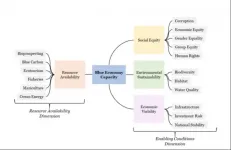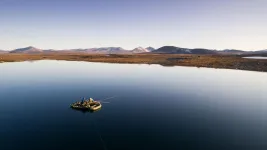(Press-News.org) Increased global temperatures help invasive species establish themselves in ecosystems, new research led by a Swansea University bioscientist has shown.
The study, published by the Royal Society, gives an insight into the probable combined effects of species invasions, which are becoming more common, and global warming.
Climate warming and biological invasions result in the loss of species. They also alter the structure of ecosystems and the ways in which species interact.
While there is already extensive research on how climate change and invasions affect species and ecosystems, we know surprisingly little about their combined effect, acting together in synergy.
This is where the new study marks an important step forward. The work, funded by the EU Horizon programme, involved Dr Miguel Lurgi from the College of Science working with colleagues from the Institut National de la Recherche Agronomique (INRAE) and the Centre National pour la Recherche Scientifique (CNRS) in France.
The team used mathematical simulations to investigate how temperature influences invasions in complex food webs comprised of 30 species. They paid particular attention to the combined - synergistic - effects.
The aim was to provide a theoretical model for how ecological communities are likely to respond to the joint effects of warming and invasions.
The model accounted for factors such as reproduction and death rates, average species body size, and interactions between species - such as predators attacking prey.
The team simulated what happens when an alien species is introduced into an ecosystem. They then ran the simulation forward in time using 40 different temperature values from 0 to 40 degrees Celsius.
This allowed them to model the combined effects on the ecosystem of temperature rises and of the new species being introduced.
They analysed the simulation results to assess the effects of temperature on food web properties before invasion, invasion success, and the effects of invasions on community structure and stability.
They found:
Warmer temperatures modified community structure and dynamics that in turn facilitated invasions.
Warmer temperatures mostly amplified the impacts of invasions on communities when compared with their colder counterparts.
Temperature effects on invasions are mostly indirect and mediated by changes in community structure and stability.
Dr Miguel Lurgi of Swansea University, lead researcher, said:
"Warming and invasions are driving major changes to our ecosystems, and it's essential that we understand their combined effects.
Our study provides a first step in that direction, analysing the synergistic effects of temperature and invasions on communities.
Overall, we found that temperature and invasion act synergistically to increase the rate of species loss, creating smaller and more connected networks.
We have seen with COVID19 how mathematical modelling has been crucial in understanding the likely spread and impact of the virus.
Similarly, our work provides theoretical expectations for the likely response of ecological communities to the joint effects of warming and invasions".
INFORMATION:
The research was published in Proceedings of the Royal Society B.
Notes to Editors
Research available here:
https://royalsocietypublishing.org/doi/10.1098/rspb.2020.2622
Swansea University is a world-class, research-led, dual campus university offering a first-class student experience and has one of the best employability rates of graduates in the UK. The University has the highest possible rating for teaching - the Gold rating in the Teaching Excellence Framework (TEF) in 2018 and was commended for its high proportions of students achieving consistently outstanding outcomes.
Swansea climbed 14 places to 31st in the Guardian University Guide 2019, making us Wales' top ranked university, with one of the best success rates of graduates gaining employment in the UK and the same overall satisfaction level as the Number 1 ranked university.
The 2014 Research Excellence Framework (REF) 2014 results saw Swansea make the 'biggest leap among research-intensive institutions' in the UK (Times Higher Education, December 2014) and achieved its ambition to be a top 30 research University, soaring up the league table to 26th in the UK.
The University is in the top 300 best universities in the world, ranked in the 251-300 group in The Times Higher Education World University rankings 2018. Swansea University now has 23 main partners, awarding joint degrees and post-graduate qualifications.
The University was established in 1920 and was the first campus university in the UK. It currently offers around 350 undergraduate courses and 350 postgraduate courses to circa 20,000 undergraduate and postgraduate students. The University has ambitious expansion plans as it moves towards its centenary in 2020 and aims to continue to extend its global reach and realise its domestic and international potential.
Swansea University is a registered charity. No.1138342. Visit http://www.swansea.ac.uk
For more information:
Kevin Sullivan,
senior press officer,
Swansea University
k.g.sullivan@swansea.ac.uk
Follow us on Twitter: http://www.twitter.com/SwanseaUni
Find us on Facebook: http://www.facebook.com/swanseauniversity
London, UK (17 March 2021)--A new study published in the prestigious peer-reviewed scientific journal Nature today offers a combined solution to several of humanity's most pressing challenges. It is the most comprehensive assessment to date of where strict ocean protection can contribute to a more abundant supply of healthy seafood and provide a cheap, natural solution to address climate change--in addition to protecting embattled species and habitats.
An international team of 26 authors identified specific areas that, if protected, would safeguard over 80% of the habitats for endangered marine species, and increase fishing catches by more than eight million metric tons. The study is also the first to quantify the potential release of carbon dioxide into the ocean ...
One of the best ways to study human evolution is by comparing us with nonhuman species that, evolutionarily speaking, are closely related to us. That closeness can help scientists narrow down precisely what makes us human, but that scope is so narrow it can also be extremely hard to define. To address this complication, researchers from Stanford University have developed a new technique for comparing genetic differences.
Through two separate sets of experiments with this technique, the researchers discovered new genetic differences between humans and chimpanzees. They found a significant ...
Stopping the spread of political misinformation on social media may seem like an impossible task. But a new study co-authored by MIT scholars finds that most people who share false news stories online do so unintentionally, and that their sharing habits can be modified through reminders about accuracy.
When such reminders are displayed, it can increase the gap between the percentage of true news stories and false news stories that people share online, as shown in online experiments that the researchers developed.
"Getting people to think about accuracy makes them more discerning in their sharing, regardless of ideology," says MIT professor David Rand, co-author of a newly published paper detailing the results. "And it translates ...
Among adults with children living in the home, cannabis use was more common in states with legalized cannabis use, according to a new study by Columbia University Mailman School of Public Health, Columbia Irving Medical Center and the City University of New York. Legalization for recreational and medical use were both linked with significantly higher prevalence of past-month and daily cannabis use. Until now, most tobacco control and harm reduction efforts protecting youth from exposure to secondhand tobacco smoke focused on parental cigarette smoking, ensuring smoke-free homes, and not smoking in the presence of children. The findings are published ...
The future of an equitable and sustainable global ocean, or "Blue Economy," depends on more than the resources available for technological advancement and industry expansion. A recent UBC-led study found that socioeconomic and governance conditions such as national stability, corruption and human rights greatly affect the ability to achieve a Blue Economy.
The study, published today in Nature, scored criteria across five global regions: Africa, Americas, Asia, Europe and Oceania, to identify the areas of investment and research necessary to develop ocean resources in a manner that is consistent with a Blue Economy ethos (socially ...
To observe how a tiny ball of identical cells on its way to becoming a mammalian embryo first attaches to an awaiting uterine wall and then develops into nervous system, heart, stomach and limbs: This has been a highly-sought grail in the field of embryonic development for nearly 100 years. Prof. Jacob Hanna of the Weizmann Institute of Science and his group have now accomplished this feat. The method they created for growing mouse embryos outside the womb during the initial stages after embryo implantation will give researchers an unprecedented tool for understanding the development program encoded in the genes, and it may provide detailed insight into birth and developmental defects as well as those involved ...
Forces acting inside the Earth have been constantly reshaping the continents and ocean basins over millions of years. What Alfred Wegener published as an idea in 1915 has finally been accepted since the 1960s, providing a unifying view about our planet. The fact that the theory of plate tectonics took so long to gain acceptance had two simple reasons. First, the geological formations that are most important for its understanding lie at the bottom of the oceans. Secondly, forces controlling the processes act below the seafloor and are hence hidden from our view. Many details of plate tectonics are therefore still unclear today.
Today, ...
Tucson, Ariz. (March 16, 2021) - This week, a new, peer-reviewed scientific study finds that there is far more potential jaguar habitat in the U.S. than was previously thought. Scientists identified an area of more than 20 million acres that could support jaguars in the U.S., 27 times the size of designated critical habitat.
The results, published in the journal Oryx, are based on a review of 12 habitat models for jaguars within Arizona and New Mexico, conclusively identifying areas suitable for the recovery of these wild cats. Based on the expanded habitat area, the authors conclude that findings uncover new opportunities for jaguar conservation in North America that ...
Researchers have channeled the universe's earliest light - a relic of the universe's formation known as the cosmic microwave background (CMB) - to solve a missing-matter mystery and learn new things about galaxy formation. Their work could also help us to better understand dark energy and test Einstein's theory of general relativity by providing new details about the rate at which galaxies are moving toward us or away from us.
Invisible dark matter and dark energy account for about 95% of the universe's total mass and energy, and the majority of the 5% that is considered ordinary matter is also largely unseen, such as the gases at the outskirts of galaxies that comprise their so-called halos.
Most ...
Imagine not a white, but a green Arctic, with woody shrubs as far north as the Canadian coast of the Arctic Ocean. This is what the northernmost region of North America looked like about 125,000 years ago, during the last interglacial period, finds new research from the University of Colorado Boulder.
Researchers analyzed plant DNA more than 100,000 years old retrieved from lake sediment in the Arctic (the oldest DNA in lake sediment analyzed in a publication to date) and found evidence of a shrub native to northern Canadian ecosystems 250 miles (400 km) farther north than its current range.
As the Arctic warms much ...


